This Might Be the Best Crossover PHEV on the Market
Ed note: It’s not often that we have two contributors reviewing the same model almost back-to-back, but with a hot new model like the 2021 Toyota RAV4 Prime it was bound to happen. You’ll see each has his own perspective, which is what these reviews are all about. We welcome your takes as well in the comments. This is Gary’s take; Steve’s can be found here.
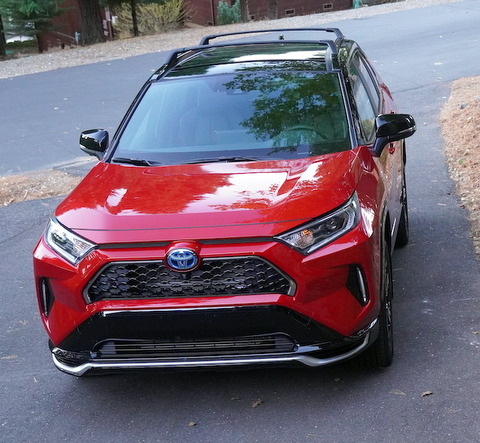
Toyota defined the hybrid vehicle market in 1997 with the Prius introduction in Japan, and since then have sold a staggering 15 million hybrid vehicles. They are the global leader when it comes to non-plug (HEV) and plug-in hybrids (PHEV).
Combine that PHEV market dominance with the company’s popular crossover, the RAV4, and Toyota has created a vehicle that is every bit as good as a conventional battery electric vehicle (BEV), and in some ways better, especially when it comes to long-distance travel.
The RAV4 is the best-selling crossover in the United States, and has 11 versions of gas-only and gas-electric hybrid vehicles. With the recent introduction of two RAV4 Prime PHEV versions, that makes 13 RAV4s to choose from. That variety provides something for every taste from the bland to the extreme.
The 2021 Toyota RAV4 Prime is a genuine PHEV that has an awesome EV-only range, rated at 42 miles, and in our tests, we think they sandbagged that range a bit as we beat it by 50 percent.
What is the RAV4 Prime?
It’s a compact utility five-door AWD Vehicle that sits on a 105.9-inch wheelbase and is almost 181-inches long and 73-inches wide.
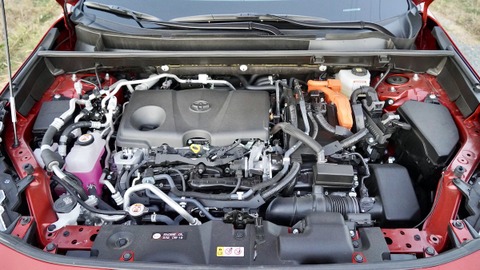
It’s powered by a combination of a 2.5 Liter Atkinson-cycle four-cylinder engine driving the front wheels, paired with an electric motor driving the front, and a second electric motor driving the rear wheels via an electronic on-demand all-wheel-drivetrain for a combined power output of 302 horsepower. Power is delivered to the front wheels as needed via an electronically controlled CVT transmission that always seemed to know the best ratio to be in (and was quiet and smooth) and through an electronic differential and electric motor driving the rear wheels.
With all that power, the two-ton RAV4 Prime can sprint from 0-60 in just 5.7 seconds, making it the second fastest vehicle Toyota sells. With both the engine and electric motors working, acceleration was turbine smooth–and fast.
The electric motors are supplied by an 18.1 kliowatt-hour (kWh) lithium-Ion battery that can be charged with either a built-in 6.6- or 3.3-kW plug-in charger. The RAV4 Prime is classified as a Super-Ultra-Low-Emissions-Vehicle (SULEV) and can operate as a gas-only, electric-only or hybrid vehicle.
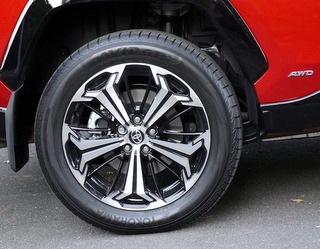
The RAV4 Prime is available in two versions, the SE and XSE. The drivetrains, battery size and other mechanicals are the same on both models, with the difference being that the XSE has more features, and a more upscale interior. The Prime SE MSRP starts at $38,100, and the XSE starts at $41,425. Both trim levels also have a destination charge of $1,120.
Our Prime XSE had all the option boxes checked, including the Premium Audio, Weather and Premium Packages that added just about every convenience and feature known to man, resulting in an MSRP of $49,577. Keep in mind because of its EV-only range, the RAV4 Prime qualifies for federal and state tax credits and rebates.
How does the RAV4 Prime drive?
During our time with our Supersonic Red and black RAV4 Prime we gave it a typical workout that any crossover owner might do, including picking up 650 pounds of wood pellets for our home heating system, getting groceries and taking a trip up into the California Sierra to visit friends.
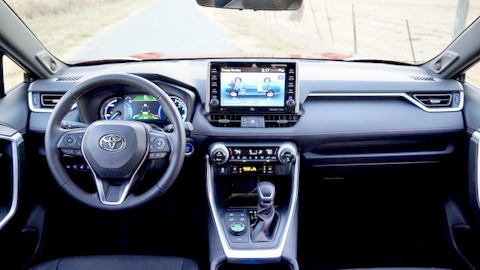
The RAV4 Prime is about the same size as other compact crossovers like the Nissan Rogue, but it had a presence that made it stand out. The RAV sits a bit higher than most competitors at 8.3 inches, but entry and exit was very easy. Cargo space is 33.5 cu. ft. behind the second row, and 63.2 cu. ft with the second row folded down. Total EPA interior space is 101.3 cu. ft., and the RAV4 prime weighs about 4,300 lbs. and has a towing capacity of 2,500 lbs.
The instruments both for the driver and for the entertainment stack were easy to read, and customizing the settings for the driver and entertainment stack were easy and intuitive. The seats are comfortable and adjustable in about every direction, but the front passenger seat lacked a height adjustment. With the XSE Premium package the seats are both heated and cooled. The JBL 11-speaker sound system was great with lots of depth and ambiance. Apple CarPlay and Android Auto are standard.

Our trip to the Sierra had us climbing from sea level to about 4,500 ft. and for that part of the trip, the EV battery was depleted to about 15%, so we were primarily using the internal combustion engine with a little encouragement from the electric motors. In that uphill section we were averaging about 36 mpg vs. the EPA rated 38 mpg, at speeds from 55 mph to about 70 on two-lane roads and the I-5 interstate. The suspension of the Prime was impressive with a smooth well-dampened ride, much like something you might expect from a Lexus or Mercedes. The steering also had that quality feel to it that made for a real premium ride. Our only complaint was that the tires transmitted lots of road noise on macadam surfaces, but the Yokohama tires were all-season tires, which had a more aggressive tread pattern. After all, the RAV4 Prime does include off-road settings for the transmission and drivetrain. The only other source of noise were the roof rack bars that whistled at speed. The cabin was bank-vault tight with not a rattle or squeak.
When we got to our destination, we plugged in the 120V L1 charger cable and four hours later the RAV4 was fully-charged and ready to go.
On our way back to the San Francisco Bay area, we wanted to see how far we could go on the EV only mode so we dusted off our hypermiling skills and were pleasantly surprised. While the stated EV-only range for the RAV4 Prime is 42 miles, we managed to stay up with traffic and achieve an outstanding range of 62 miles before the gas motor started up. Even at that, the rest of the trip on flat freeway driving, the gas motor would shut off and we would end up gliding on EV only power. With the EV mode augmenting the regular gas engine our mileage range increased to 52 mpg. The round trip was 320 miles, half with an average mpg of 36 mpg, and the other half at an average of 52 mpg. At the end of the trip the 14.2-gallon gas tank still had about half of its 87-octane fuel left for a trip average of about 44 mpg.
Is a PHEV the better EV for long-distance travel?
This is a touchy subject, with pure BEV proponents turning up their noses at anything that burns even the slightest bit of petroleum. But there are also those who feel that using the proper tool for the job is the better approach.
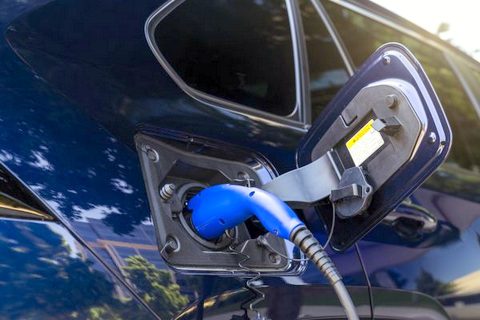
PHEV advocates contend that at this point in time, BEVs are an excellent choice for urban and inter-urban travel and as a daily driver. BEVs shine when it comes to low speed travel and are extremely efficient in stop and go traffic. They are the perfect replacement for an ICE daily driver, and study after study has shown that 85-95 percent of all vehicles are driven primarily in this environment.
But many other studies and owners’ reported experiences have shown that long-distance travel is the BEVs Achilles’ heel. More and more BEVs are available today that boast EPA and other range results of 300 or more miles, while actually only delivering at least a third less real-world range.
The current BEV mileage champs like Tesla boast 300+ miles of range on the majority of their models, and have one of the better recharging infrastructures today, but owners are surprised and disappointed when they find that real-world range at real-world highway speeds of 70-80 mph only deliver 150-200 miles of that advertised range. Add to that the necessity to recharge more often that adds a significant time penalty to a trip that an ICE can accomplish on one tank of gas. Combine the hurry up and wait time lost in charging along with the relative scarcity of reliable high-speed charging in areas other than interstates and urban areas, and that adds a significant time and enjoyment penalty to driving a pure BEV on a long trip. Many BEV owners are willing to take a step back in time efficiency when it comes to long-distance travel perhaps because of the novelty of BEV travel, but the mainstream long-distance driver finds their time more valuable than trying to show off.
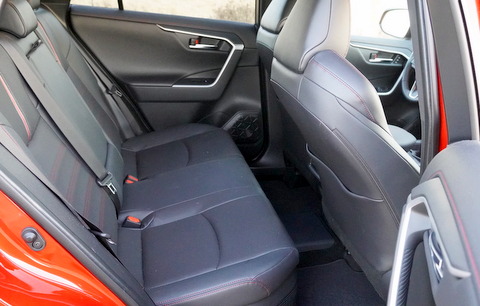
A PHEV on the other hand takes the best of both the ICE and BEV world and lets the vehicle work with the tools that are most efficient. It’s a BEV when starting from an urban area, a gas/electric vehicle on the majority of the high-speed highway section, and back to being a BEV once the vehicle has arrived at its destination. And because it does not have a huge battery to recharge, 120v L1 charging is actually useful.
A PHEV isn’t afraid to get off the beaten path either, as the range of a PHEV is much greater than any BEV, and gasoline is available in even the most out-of-the-way backroad. The RAV4 Prime can easily accomplish a 650-700-mile trip without refueling or recharging though one’s bladder may not be as accommodating.
So yes, a PHEV may be a better choice today over a BEV if long-distance travel is a significant portion of the anticipated driving.
Pricing
The 2021 Toyota RAV4 Prime is available in 2 trim levels:
XE AWD SUV – $38,100
XSE AWD SUV – $41,425
Destination Charges – $1,120

There are a variety of option packages and for more information on them visit the RAV4 Prime site.
The RAV4’s popularity has caught quite a few off guard, including Toyota. Combine this with the Covid-19 constraints, and this Japanese manufactured RAV4 is selling as quickly as they are being made, and in some cases, dealers are taking advantage of the scarcity to add quite a bit of dealer markup. We reached out Toyota representative on when supply may catch up with demand and they responded that “Our intent is to increase volume in CY21 as much as possible for us, conditional on the market situation at the time.”
Warranty and Maintenance Coverage
- Comprehensive – 36 months/36,000-miles
- Powertrain – 60 months/60,000-miles
- Corrosion Perforation – 60 months/unlimited-mileage
- Hybrid System – 96 months/100,000 miles
- Hybrid Battery (transferrable across ownership) – 10 years/150,000 miles
- Restraint Systems – 60 months/60,000 miles
- ToyotaCare – Complimentary maintenance plan with the purchase or lease of every new Toyota. For two years or 25,000 miles, whichever comes first, every new Toyota will be covered for all normal factory scheduled service, as well as 24/7 roadside assistance.
Summing it Up
The RAV4 Prime PHEV is a significant vehicle for Toyota and a major part of its strategy to offer more than 40 new or updated electrified vehicles by 2025. Toyota continues to be the global leader in hybrid and alternative fuel vehicles and will be using this market dominance to expand with more and more zero emission vehicles in the next five years.
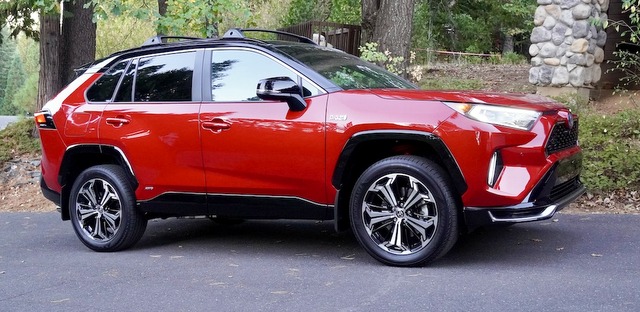
The RAV4 Prime is one of the company’s gems, built on its leadership in hybrid powertrains and legendary quality. It is a best-in-class SULEV and a worthy alternative to a BEV, especially if long-distance travel is an important consideration in buying an electric vehicle.
If a long-distance BEV is high on your consideration list, consider the RAV4 Prime as a worthy alternative. Visit the RAV4 Prime site for more in-depth information.
Make sure to opt-in to the Clean Fleet Report newsletter (top right of page) to be notified of all new stories and vehicle reviews.
Story and photos by Gary Lieber.
Related Stories You Might Enjoy—Compact Crossovers with a Plug
Road Test: 2020 Hyundai Kona Electric
Road Test: 2020 Kia Niro Electric
Road Test: 2020 Kia Niro PHEV
News: Jeep Wrangler to Get PHEV in 2020
News: Jeep Renegade & Compass Go PHEV
Road Test: 2019 Mitsubishi Outlander PHEV
Flash Drive: 2020 Hyundai Nexo FCEV
Road Test: 2019 Subaru Crosstrek PHEV
News: Volvo XC40 Recharge EV Car of the Year Finalist
News: 2020 Kia Soul EV Debuts
News: 2021 Ford Mustang Mach-E Update
Road Test: 2020 Mini Cooper EV
Disclosure:
Clean Fleet Report is loaned free test vehicles from automakers to evaluate, typically for a week at a time. Our road tests are based on this one-week drive of a new vehicle. Because of this we don’t address issues such as long-term reliability or total cost of ownership. In addition, we are often invited to manufacturer events highlighting new vehicles or technology. As part of these events we may be offered free transportation, lodging or meals. We do our best to present our unvarnished evaluations of vehicles and news irrespective of these inducements.
Our focus is on vehicles that offer the best fuel economy in their class, which leads us to emphasize electric cars, plug-in hybrids, hybrids and diesels. We also feature those efficient gas-powered vehicles that are among the top mpg vehicles in their class. In addition, we aim to offer reviews and news on advanced technology and the alternative fuel vehicle market. We welcome any feedback from vehicle owners and are dedicated to providing a forum for alternative viewpoints. Please let us know your views at publisher@cleanfleetreport.com.

22 thoughts on “Take Two: 2021 Toyota RAV4 Prime PHEV”